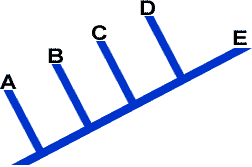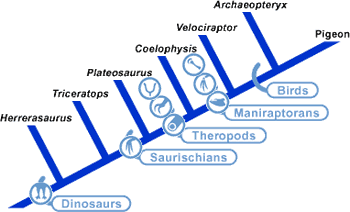








We can infer that the features served a function other than flight.

Question 1:
Suppose that we have found long, fang-like teeth in critters C, D and E. Where would you map the earliest appearance of this feature on the cladogram?
Question 3:
Imagine we found a fossil of species F, but have not recovered its jaw. Do you think this species had fangs?
| Yes | |
| No |
Question 4:
What can we infer from the skeletal features mapped on this cladogram?

| All flight features evolved all at once. | |
| Flight features evolved at different times. | |
| All flight features were present in the earliest dinosaurs. | |
| No flight features were present before birds. |
Question 5:
The functions of each of the skeletal features we explored are associated with flight, but many appear quite early in the dinosaur lineage. With this information, we can infer that:

| Most of the features were unimportant. | |
| Very early dinosaurs could probably fly. | |
| The features originally served a function other than flight. | |
| The only feature that matters is the shoulder. |
Remember to map the feature before the most recent common ancestor of the three organisms that have the fang-like teeth.
It might seem logical because the critters that follow all have fangs, but be careful—is there direct evidence, or are we making an inference?
Look carefully at the cladogram. We have direct evidence that C, D and E all had fangs, so we can map the first appearance of fangs before the branches that lead to C, D and E.
Take a close look at where each of the features is mapped on the cladogram.
Take another look at the cladogram and what is being asked. The real question is "Why would features associated with flight appear in animals that don't fly?"
Since critters C, D and E all have such teeth, we can infer that fangs evolved in the ancestors before them.
Since the fangs appeared in critters C, D and E but NOT in A or B, we can only infer that fangs probably evolved in the lineage before it appears in C, D and E.
The presence of fangs in critters C, D and E actually provide us with indirect evidence that critter F most likely had fangs as well. Therefore we can make the inference that critter F had fangs.
Flight features evolved over a long period of time.